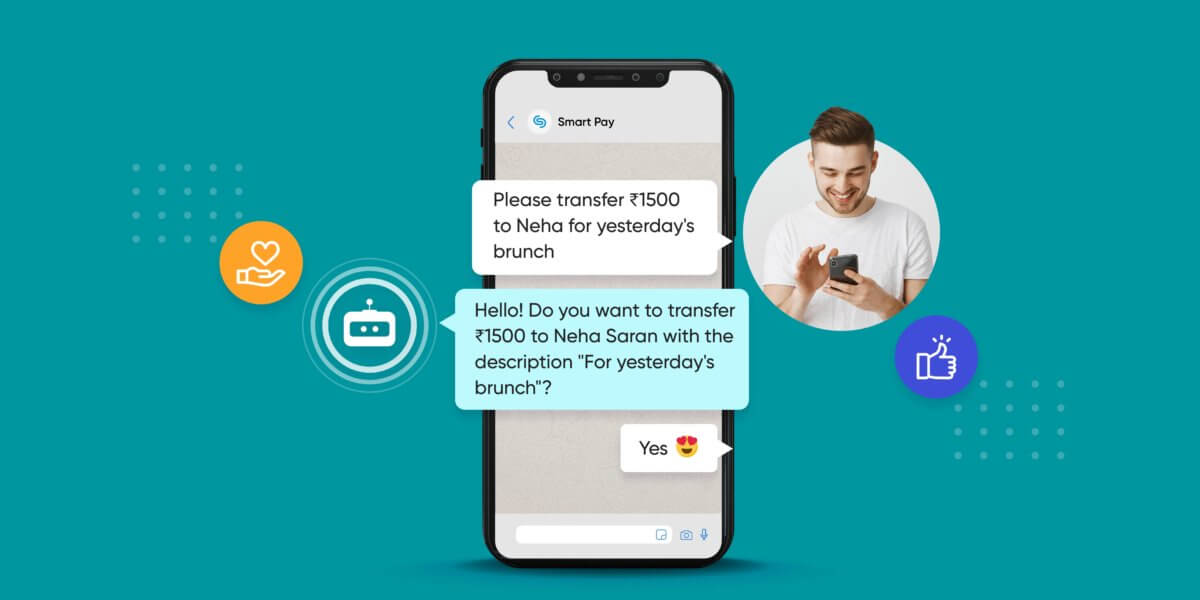Voice AI: The Ultimate Guide
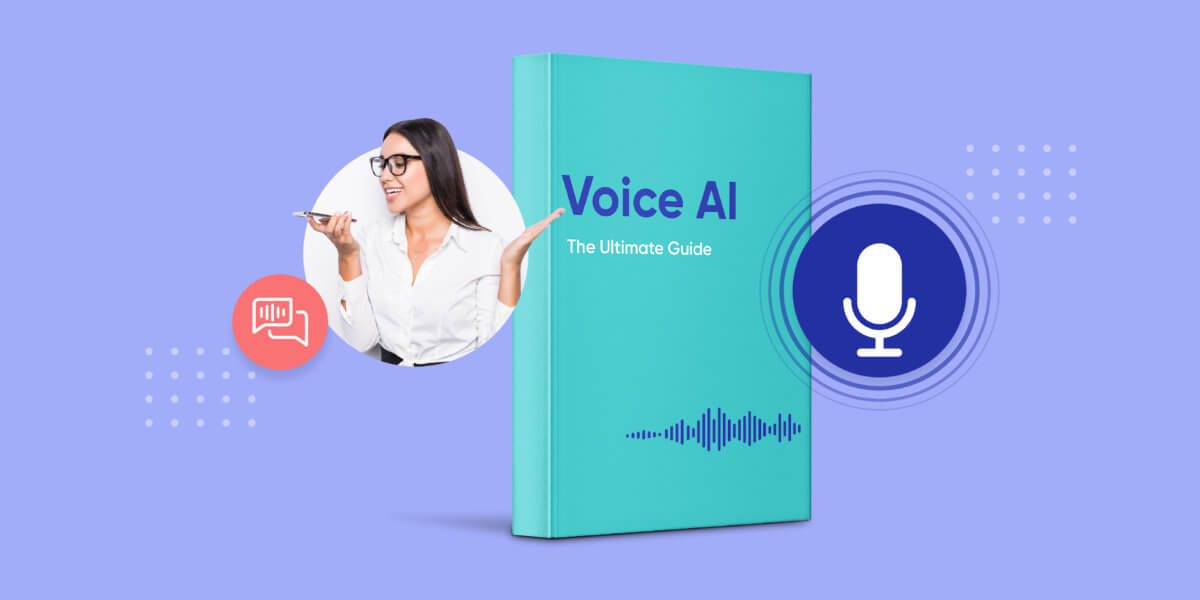
Voice AI: The Ultimate Guide
Here’s everything you need to know about Voice AI chatbots. In this guide we cover what is voice AI, how does a voicebot work, latest trends, and its use-cases
The way we communicate with our customers has come a long way since technologies evolved over the years. Communication was more direct, personalised, and mostly occurred in person. However, since the advent of the Internet, a lot has changed. More so in the post-pandemic world where users and businesses are online and using AI more frequently with voice chatbots.
Customer support is now online too. And to streamline the process, many businesses are now adopting artificial intelligence. Along with chat, conversational AI, AI-powered voice-activated chatbots are emerging as an alternative support system that can simplify the complexity of human speech.
Speech is the quickest way to communicate for a modern digital business today. Voice-enabled chatbots are faster than emails, call centres, or navigating support sections on a company’s website. Unsurprising to say, voice AI software bears the immense potential to augment the way your business speaks to your ideal customer.
Voice recognition chatbots can elevate experiences not only for your customers but for you as well. For example, you can design your bot’s conversation flow for it to work as a full-time lead generation tool. Your voice response chatbot can give relevant product suggestions to users making them more likely to convert and become a lead.
In this blog, we’ll be diving head-first into the world of voice AI – what it is, why you need it, and how it works. Here is a quick table for you to navigate the page easily.
Table of Contents
Comparing: voice chatbot vs voice assistant
Comparing the two most efficient ways of providing customer support: Voicebot vs chatbot
Top trends and predictions: Are voice chatbots the future?
- Voice AI is perpetually growing and becoming more human
- Increasing awareness is fueling rapid voice AI adoption
- Internet of Things and ecosystems are booming
- Data security and privacy are more important
How does voice AI chatbot work?
- Absorbing and understanding the input
- Eliminating background noise and ambient sounds
- Switching to neural processing
- Further processing using syntactic and semantic methods
- Narrowing down the final response
- Time to send it out!
Voice chatbot examples: How different industries use voice AI
How can a voice chatbot help in customer service?
- Offer quick customer self-service
- Optimise ticket assignment
- Talk to them in their language
- Let your users speak their minds
- Save extra hours
- Stay active around the clock
Is it safe to use a voice chatbot?
Voice chatbot benefits: How well do voicebots perform generally?
What is a voice chatbot?
A voice chatbot is a conversational AI communication tool that can capture, interpret, and analyse vocal input given by the speaker to respond in similar natural language. Users can interact with a voice AI chatbot with voice commands and receive contextualised, relevant responses.
Shopping online or just plain browsing can leave customers with many questions about your products and services. A voice recognition-enabled bot can answer these questions in real-time easily, accurately, and cost-efficiently.
Voice chatbots take AI chatbots to the next level by letting customers communicate with the AI using natural speech. You can talk to the voice chatbot just as you would to someone in person and have the bot respond in a voice of its own. Natural language processing makes interacting with the voice chatbot effortless. People are already used to interacting with voice assistants in their homes with Alexa, Siri, and Google Assistant.
But how are voice bots and voice assistants different?
Comparing: Voice chatbot vs. voice assistant
Both voice chatbots and assistants rely on the same technology – Natural Language Processing (NLP) to understand human speech and deliver relevant speech-based results.
However, they’re pretty starkly different from each other in many aspects.
Let’s examine the differences between voice AI chatbots and the voice assistants we use in our everyday lives.
Voicebot features
Voice bots made for customer service address a different predicament that customers face while browsing websites. As more people get used to using voice as the primary mode of interaction with all of their smart devices, text-based input begins feeling sluggish and inconvenient. Voice chatbots exist to solve this problem.
Your users can hop onto your app and ask the voice chatbot to suggest products, understand the specifications, or even explain any problems they might have run into while placing their order.
They can do all of this around the clock and get a response instantly, which is what makes voice-enabled chatbots so appealing. Convenience is the name of the game when it comes to customer support.
Voice assistant features
We’re all familiar with voice assistants embedded into our phones and other smart devices. Amazon’s Alexa, Apple’s Siri, and Google’s Assistant are examples of voice assistants that we know and love.
Here are some of their features:
- Control smart devices such as lighting fixtures and thermostats using voice
- Exist locally on the device, and users rely on dedicated hardware such as smart speakers
- It can act as an interface to interact with other services and apps
- Create routines that can automatically run based on predetermined parameters
Suggested Reading: How is Voice AI Changing Contact Center Experience in the Middle East?
Comparing the two most efficient ways of providing customer support: Voicebot vs chatbot
Customer support over the phone is excellent yet is time-consuming and inefficient for businesses. It can quickly run up operating costs that eat into your revenue.
Voice and chatbots are more efficient customer support channels that allow you to engage with your customers in real-time with minimal investment and operating costs. You might wonder which of the two is a better alternative for your business.
We’ll break down the differences between the two so you can make an informed choice:
What differentiates voicebots?
A voice bot uses natural language processing technology to interpret vocal user input and the context to interact with the user. A user can say anything to the voice bot in a natural language without using specific commands. Artificial intelligence identifies markers in the speech to piece information together and match it to the dataset it’s been trained with. What’s great about voice bots is that they’re learning continuously. AI makes every future interaction that much more seamless than the previous one!
They provide a much more immersive and personalised experience that dramatically appeals to customers, especially younger ones.
Communicating by voice is also much faster than texting; it’s the most natural form of interaction that we use as humans. Interacting with a voice bot is as easy as talking to a friend who knows everything you’ve ever wanted to know.
How do chatbots differ?
On the other hand, chatbots also use artificial intelligence to process text-based interactions with users. You can use them to automate most conversations with customers. They can respond in natural language that doesn’t sound robotic. Millennials like live chat support channels, and it is the preferred customer support channel for customers belonging to this demographic.
The one distinguishing feature between the two is how they communicate with users. Voice bots use voice interactions, while chatbots rely on text-based interactions. There is no conclusive answer to which is better than the other, but one may appeal to your customers more than the others, depending on your target demographics, industry, needs, etc.
Voice bots also contribute to better customer satisfaction than chatbots. But this depends on how comfortable your customers are with using their voice to interact with intelligent voice bots.
Quick comparison table: voicebot vs chatbot
| Feature | Voicebot | Chatbot |
| Mode of communication | Speech | Text |
| Technology | Machine learning, NLP | Machine learning, NLP, Artificial emotional intelligence |
| Speed | Faster than chatbot | Faster than phone/email support |
| Automation | Yes | Yes |
| Omnichannel | Yes | Yes |
Top trends and predictions: Are voice chatbots the future?
Voice AI has come a long way in the past couple of years, and so has the adoption. It used to be a rudimentary prototype that was rough around the edges. Today, with the help of artificial intelligence and large data sets to train it, we’re able to make complex voice chatbot capable of processing natural speech, phrases, and slang, as well as the context behind it.
1. Voice AI is perpetually growing and becoming more human
Voice AI technology is still young and evolving to be more yielding every day. AI works by identifying patterns in the training dataset. The dataset is constantly updated by adding new interactions, refining the experience each time you use it.
Another likely improvement is making voice bots seem even more natural and human-like in the next few years. This natural feeling will further bridge the gap between humans and AI and fuel adoption.
Brands are now using more robust NLP technologies to train and improve the voice AI software they use. While a voice-centric future is on the cards, many major brands already recognise the value proposition of voice chatbots.
We back it up with numbers: The global voice recognition market is on the mark to boom. Statista shows a whopping 154% jump in the voice AI market share from 2020 to 2026.
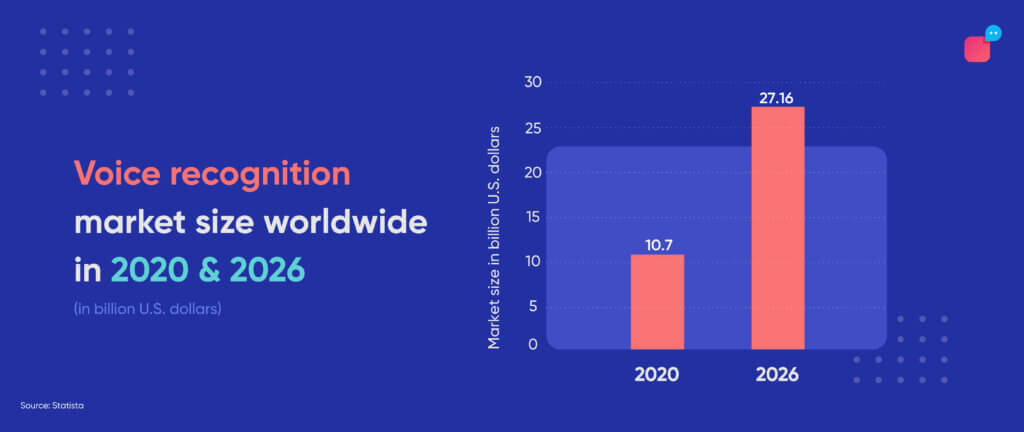
2. Increasing awareness is fueling rapid voice AI adoption
As people continue to adopt smart home technology and voice assistants, they will likely expect the same standard of hands-free convenience from brands they interact with. Voice chatbots are arguably the future of interaction and will be the mode of input of choice in the next couple of years.
There is far too much on offer for brands to ignore:
- better insights,
- quicker response times,
- higher satisfaction rate, and
- reduction in operating costs.
These are just some of the many things that will drive the adoption of voice chatbots in the future. The adoption of voice bots is significantly faster among younger audiences.
What do the numbers say? eMarketer reports that 35.8% of millennials use voice-based digital assistants at least once a month. Rapid adoption of voice AI among people is having a significant impact on online shopping experiences for people. Voice AI is leading global shopping experiences worldwide. Take a look at the growth of voice-based shopping between 2018 and 2022.
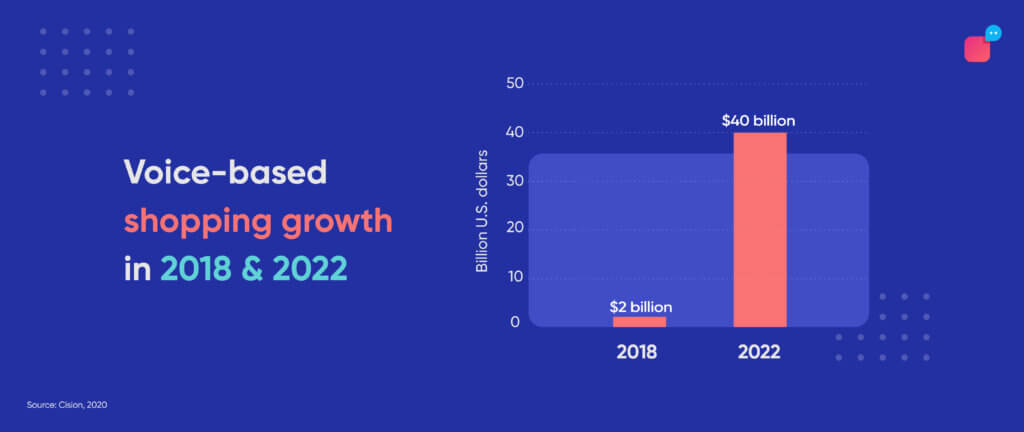
3. Internet of Things and ecosystems are booming
Over the coming years, you can expect voice-based bots to integrate into various other products and services that will allow them to form a pervasive ecosystem. Voice-based chatbots are the foundation of the Internet of Things of tomorrow. With devices getting smaller and screen real estate becoming a luxury, voice chatbots give customers the best of both worlds with quick, accurate information delivered entirely hands-free.
Let’s talk numbers, shall we? IoT is predicted to grow exponentially throughout the decade – especially in India, Southeast Asia, the Middle East, North Africa, Australia, and Latin America.
Here are the percentage increases in the number of IoT connected devices between 2020 and 2030 in the above mentioned regions.
| Region | 2020 | 2030 |
| India and South Asia | 128.2 | 785.1 |
| Southeast Asia | 165.9 | 798.3 |
| Middle East and Africa | 151.6 | 623.7 |
| Australasia | 104.3 | 355.4 |
| Latin America | 370 | 1371 |
| Europe | 1875.1 | 5598.4 |
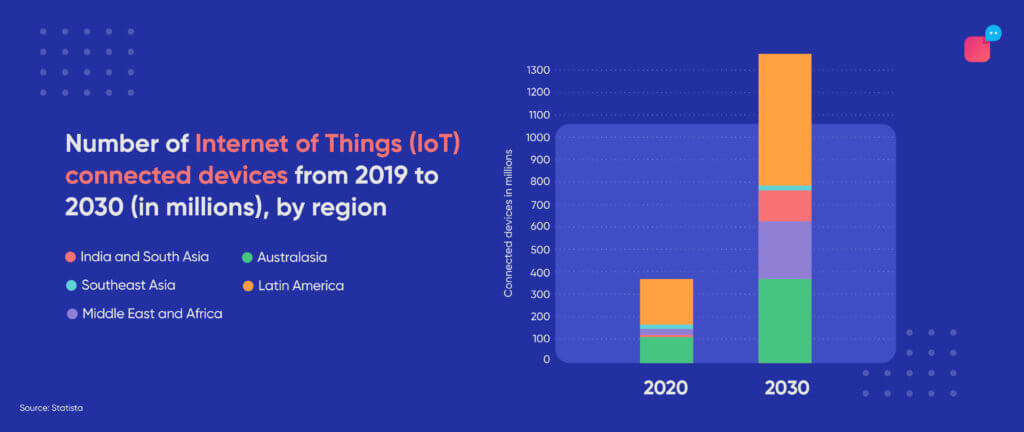
4. Data security and privacy are more important
A stronger emphasis on security and privacy is likely as the voice bot technology advances. We store everything on our phones and may require to share sensitive information with AI-enabled bots. Data security is a grave matter for users, which is why more businesses adopting AI would choose vendors that boast vaulted safety.
Voice AI can ID the speaker’s voice and associate all of the user’s content to their specific ID so nobody unauthorised can access it.
What do numbers say? IBM says companies with no automation or AI security lose an average of $6.71 million per breach. On the bright side, companies with AI security bear $2.9 million in costs on average. In conclusion, yes. Deploying voice AI with armoured security can save up some coins.
Suggested Reading: Why Voice-Based Customer Support is the Future?
How does voice AI chatbot work?
Many people use automation and artificial intelligence interchangeably. However, there are many ways to differentiate between the two. General automation works great for tasks that are:
- Repetitive
- Have high volumes.
In such a case, automation tools can simplify completing manual and laborious tasks. An example would be going through a call centre IVR and press numbers on your phone to get the required information on their automated support helpline. However, the voice chatbot architecture is built differently.
Voice chatbots go a step further and automate tasks with reason and logic.
One of the most pressing issues that customers face while interacting with different AI is their lack of contextual understanding. Conversational AI solves this. Contextual awareness is a key determining factor in the voicebot development process.
So, how does a voice chatbot work?
Conversational Voice AI platforms can now understand natural human language and make sense out of it on their own. As a concept, this was incomprehensible to the general public for long. But now, with most commercial operations occurring online, conversational AI chatbots and voicebots are becoming a market essential.
Voice chatbots constantly self-learn to give better, more logical answers after each interaction.
Understanding language works on encoding and decoding of a message. Voice recognition AI works on a similar principle. Here is a detailed step-by-step explanation of how voicebot works.
1. Absorbing and understanding the input
The first thing a voice chatbot speech system would do is try understanding the context of the input or the message received. Voice-enabled chatbots catch, interpret, and analyse the sound waves generated by the user while asking the query to break them down into simpler and understandable fractions of text.
With advanced Automated Speech Recognition (ASR), the bot can filter out irrelevant sounds to understand the speaker’s language, accent, and intent.
A robust voice chatbot’s ASR is trained on thousands of hours of call recordings and contextual speech recognition. You would require a pre-speech recognition system to break down the spoken words into bits and groups. This way the AI algorithm converts the information and can process it much more easily than complex human speech.
2. Eliminating background noise and ambient sounds
One thing that usually and inevitably creeps while speaking into a microphone is the background sound. Now, this could be the usual people chatter, car horns, and similar disturbances that can distort the information spoken. Voice AI, along with sound waves of substance, picks up these noises in the background.
However, AI is sensitive to additional sound that comes along and can differentiate between noise and the actual message using a neural network.
3. Switching to neural processing
Although quite hard to replicate, the voice chatbot’s neural network aims to process information like a human neurological system. The simplified data goes through another round of processing where it is further broken down to find a logical and relevant output. Voice chatbots can read and analyse every bit of this data, understanding the actual meaning behind the input to narrow down to best possible output responses.
This is made possible by Natural Language Processing and Natural Language Understanding. NLP/NLU models of a voice chatbot are trained on datasets specific to industry use cases to understand the user intent, use-case specific entities and user sentiment.
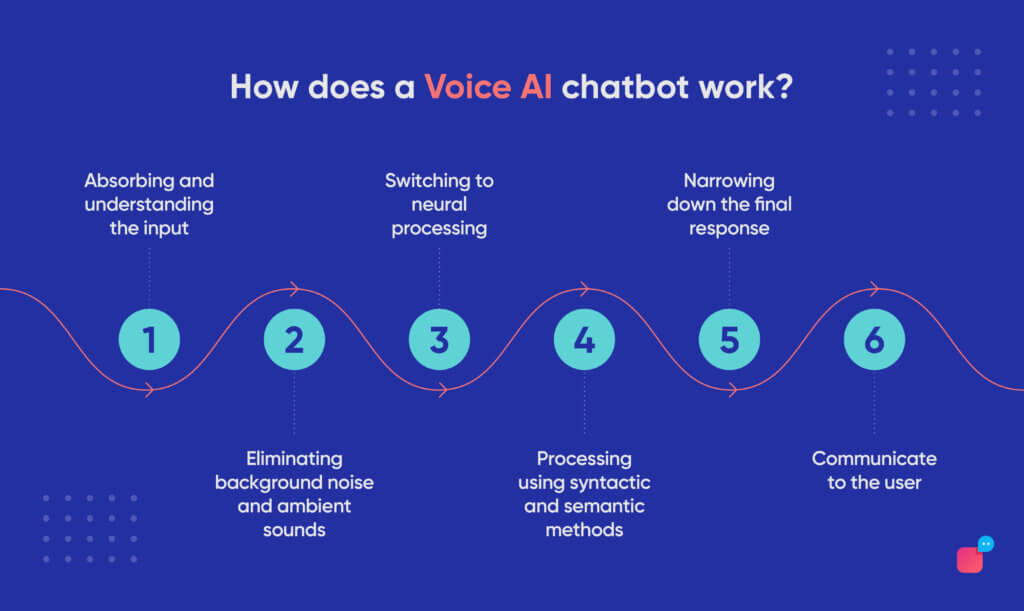
4. Further processing using syntactic and semantic methods
Now, it’s time for the voice chatbot to dig deeper into the input. Using syntactic and semantic techniques, voice AI can now further process the message to gain an understanding of the underlying context and user intent in question. Conversational AI attempts to absorb, understand, and reply in a way a human would. While this is a complex process, a robust voice chatbot can perform the back-end processing quite efficiently. A voicebot equipped with semantic analytical techniques can understand the underlying meaning behind natural sentences and words. At the same time, the syntactic system looks to identify and process the information using grammatical rules.
5. Narrowing down the final response
Based on a thorough evaluation of the input given by the speaker, the voice AI chatbot reaches a particular range of conclusions. Now, to find the best response, the voicebot analyses and filters potential answers to find the one that most accurately and logically answers the user’s question.
6. Time to send it out!
Once the voice chatbot knows what to present as the response, it quickly converts the answer into an audio format using a text-to-speech system. You can train your voicebot’s text-to-speech system with industry-specific cases so that it can understand the relevant audience and respond naturally with a voice of its own. These saved responses are helpful in picking up conversations in future from where the user left off previously. This ensures an unhindered conversational flow of support conversations.
Suggested Reading: Voice AI: What is it and How Does it Work?
Voice chatbot examples: How different industries use voice AI
1. Voice AI in healthcare
The healthcare industry is quickly adopting technological advancements to pave the way for telehealth products and services.
Major healthcare institutions such as Mayo Clinic, American Red Cross, and Cleveland Clinic have already recognised the value hands-free AI-based communication technologies can add and implemented them in various ways.
A research paper published in Nature discusses the viability of using voice-based chatbots in the healthcare industry. The study found that technology can augment the way healthcare is administered today. For instance, hospitals can use it to
- Screen for symptoms and diagnose diseases
- Provide first aid and emergency tips,
- Give healthy nutrition advice,
- Improve the overall patient experience
- Streamline scheduling appointments
If your healthcare provider has a voice chatbot that’s accessible around the clock, getting reports and other important information can be as easy as just asking for it.
Voice AI is more relevant than ever before in a post-pandemic world that has almost entirely switched to digital platforms. For example, search terms like coronavirus tips are at the top of search term trends across search engines. However, customers would prefer to have their healthcare provider provide them with legitimate information that they can rely on.
2. Voice AI in banking
Privacy is one of the most important things to consider in banking. Often, clients face issues or need help while making a transaction and speak with someone who can walk them through it. However, one problem is that people are hesitant to discuss their financial information with people over the phone, which is no surprise.
Customers can be more comfortable asking an intelligent voice chatbot to answer all their questions and without revealing any privileged financial information to anyone on the phone.
Clients can have secure, encrypted conversations in natural language with voice chatbots and be sure to receive the most accurate information without compromising on speed, clarity, or privacy.
Banks can design their voicebot to solve industry-specific functions. There are various use-cases for voicebots in the banking and finance industry:
- Provide financial tips that are custom-tailored to each customer.
- Perform time-critical tasks like blocking a lost card, show previous transactions, etc.
- Use layered verification to approve settings
- Help assess the risk appetite of clients
- Help clients choose the right financial products for them
- Voice chatbots can personalise marketing campaigns and make them more effective.
- Banks can train the AI voice chatbot to identify patterns in fraudulent activity and stop it from happening, thereby reducing the risk of fraud.
How did it work in real life? Kotak Mahindra Bank, one of the leading banks in India, decided to deploy an AI-powered voicebot “Keya”, to streamline its customer support function. The bank’s key pain points were overburdened agents, reduced productivity and bumpy support cycles. The experiment was a resounding success. 70% of the customers interacted with Keya before speaking to a live agent. The voice bot was also able to accurately deduce user intent 87% of the time and reduce the overall response time by 50%.
3. Voice AI in call centres
Call centres are always riddled with an unending inflow of support queries. They receive thousands of calls every day, and most of them are about common issues or don’t require human intervention. However, call centres are only as efficient as the support agents working there. They’re bound to feel tired over time and cannot be available around the clock.
Voice AI can help overburdened agents by leading the end-to-end resolution cycle. A voice AI can do most things a call centre can but without the downtime of waiting for an agent to get back to you with the required information.
Customers don’t have to wait in a queue and talk to the call centre voice chatbot just as they would to an agent to receive quick answers. Call centres can entertain high call volumes (in hundreds or thousands) and simultaneously present for their customers.
4. Voice AI in gaming
Games provide another compelling use case for Voice AI. Gaming is all about immersion in the experience, and when customers run into bugs and glitches, it can be frustrating with no one to talk to.
However, a voice chatbot can help take feedback, allow players to report bugs, and even complete tasks in-game by talking to the voice AI. Voice AI in gaming is creating rich and surrounding experiences for gamers worldwide.
Take a look how: Fridai is an excellent example of how you can use voice AI in gaming to augment your gaming experiences. It’s an assistant that operates on your computer alongside games like Minecraft, FIFA ‘20, Red Dead Redemption 3, etc.
You can call on Fridai using your voice while you’re gaming to perform functions like recording the screen, sharing clips to social media and streaming platforms, and giving walkthroughs of levels in-game. This functionality is great for gamers who don’t want to bother leaving their game to get through countless menus just to share their content.
Suggest Reading: How to Measure the Success of Your Voice AI Bot?
How can a voice chatbot help in customer service?
Voice-activated chatbots will play a crucial role in customer service. Today, there is so much your users can get done by simply using their voice, even when your support agents are offline. Artificial intelligence backed support tools are consumer-first. It is no different for voice AI.
Positive CXs can help you circulate happy word-of-mouth. Your customers will likely interact with your business again and, better yet, refer it to their friends and family.
Voice bots are a unique feature that you can implement to get more organic traffic to your website. High engagement and lightning-fast resolutions mean you are able to keep a lot more users gripped to your platform. This can give you a competitive advantage in the market too.
But how does a voicebot make customer support lean?
1. Be there, with them
Harvard Business Review says that 81% of customers prefer to resolve queries themselves before reaching out to a representative. This comes as no surprise because it’s just a better and easier way to access information.
A voice chatbot is a self-service tool that does the same. Your customers value getting quick resolutions more than speaking to an agent. Conversational AI voice-enabled chatbots serve as an outlet for your users to voice their problems, quite literally, and receive vocal responses within nanoseconds!
2. Ticket assignment made easy
Voice AI can optimise ticket assignments for you. Your voice chatbot can readily solve most of the incoming support queries. But at times, some queries can be too complex and go beyond the voicebot’s purview. This is when a support conversation may need an agent’s help. Your voice chatbot can seamlessly transfer complicated and high-priority cases. This can reduce the Average Handling Time (AHT) and save your team’s productive hours and resources.
3. नमस्ते! Selamat pagi! !أَهْلًا وَسَهْلاً
Implementing a voice AI on your website can help you serve customers from different regions without the language barrier.
You can train the voice AI to speak in as many different languages as you’d like. You can make it default to a regional language based on the visitor’s IP address or give them the option to choose the language of their choice manually. It also makes your website inclusive of linguistic differences, which is a great look for your business.
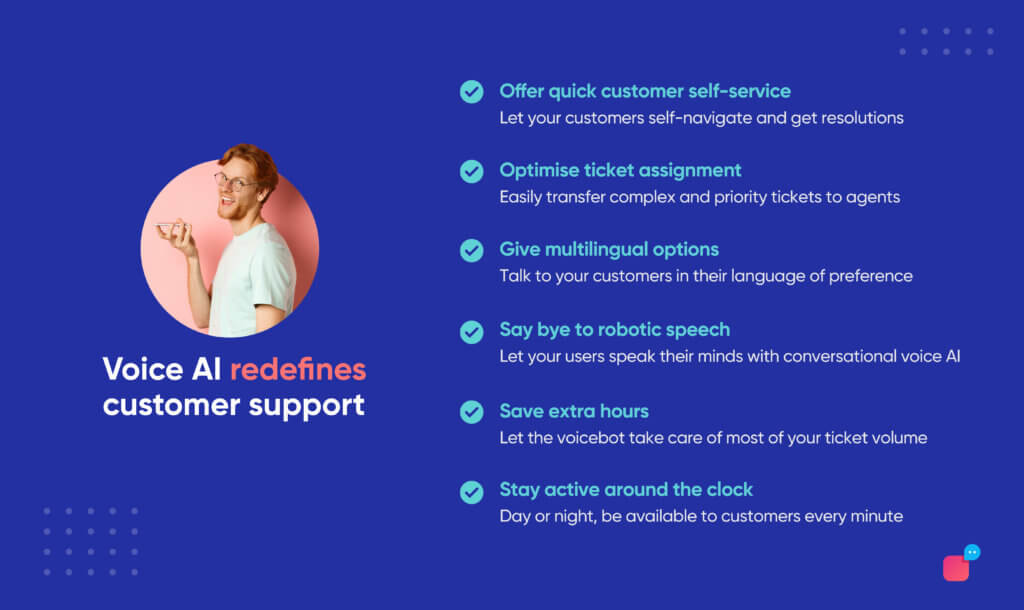
4. Let your users speak their minds
AI and NLP are the brains behind customer support voice bots. With semantic analysis, understanding users becomes a lot easier. Your customers will appreciate that they no longer have to worry about whether the AI will understand what they mean. The AI can process and understand the intent behind the message and reply accordingly in natural language. Context-awareness makes interacting with it as easy as talking to a friend. Contextual Relevance is the key to make AI work the way it is expected to.
Voice AI can handle thousands of customers’ queries simultaneously and give accurate answers instantly. It can considerably enhance user experiences and shoot up your CSAT report.
5. Free up more hours
Running a support channel that is active around the clock is a huge time investment. A voice bot is an excellent investment that can help you operate your customer support at higher efficiency with no live agent support needed for elemental queries.
6. “Sorry, we’re closed?” Nope!
You don’t want to miss out on a potential customer just because your live agents weren’t there to assist the visitor. Artificial intelligence ensures that you don’t.
An AI-powered voicebot is ready and happy to help around the clock, no matter what day of the week it is so you always attend to your visitors.
Suggested Reading: If You have a Customer Support Team, You Need Voice Chat
Is it safe to use a voice chatbot?
More and more users today are becoming tech-savvy. We browse, search, sign-up, shop, pay – all on the Internet now. This is why data privacy reigns supreme for users today. At the same time, users are also conscious about the data they share online, whether personal or financial.
There are some risks speakers using voice AI may run into like fraudulent use of their voice recordings, remote control, poor user authentication methods.
The risk of a data breach increases when users divulge the information to a number of people, which may happen when the user gets transferred from one agent to another.
Voice AI or voice chatbot, however, runs a lower risk of fraudulent activities. It also completely eliminates any possibility of human error that might creep in when users reveal data during conversations. A robust voice chatbot is completely secured in the way it:
- Collects data
- Stores data
- Accesses the data
A powerful voice AI application ensures that the user’s data is protected by a military-grade firewall that miscreants find hard to hack into. Best voice chatbots are also PII and GDPR compliant to ensure standardised safety.
A few ways you can protect yourself from getting scammed by non-trusted voice AI providers are minding what you share online, turning off the mic and location access when not needed, using WPA 2 security for WIFI and strong passwords for accounts.
Voice chatbot benefits: How well do voicebots perform generally?
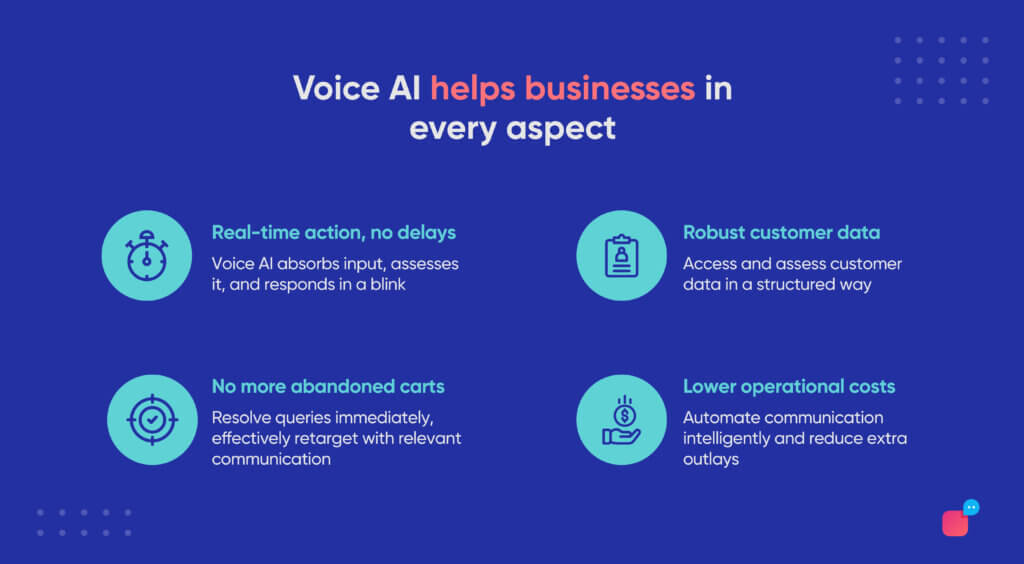
While 24×7 availability and ease of access are some of the voice chabot advantages, there’s more voice tech can do! There are many benefits to using voice bots and chatbots to interact with your customers:
1. Everything is real-time
Voice chatbot has many benefits to customers. When a customer is looking for an answer to your product or service query, they shouldn’t have to wait minutes on the phone for a simple solution. Chances are, they’d probably choose to shop elsewhere where the answer is readily available. A voice AI program can address this problem by providing instant support to those who need it. It’s highly effective in most cases and can operate entirely autonomously. However, if the customer requires additional support, the voice chatbot can instantly connect them to a live support agent.
2. In data, we trust
One big perk voice chatbots have is their ability to gather user data. Understanding users, their preferences and expectations become a lot easier with access to extensive customer profiles.
A voicebot can also keep an organised record of all the previous conversations for you to know the pain points and problems your users face on a daily basis. This way you can track user behaviour and customise your offerings to specific cohorts using a voice chatbot application.
3. No more abandoned carts
When users cannot find answers to questions about offerings on your website, their first instinct is to ask for customer support. However, if they notice that it takes more effort to call customer support than to look it up online, they most likely will choose to do the latter. This can shoot up your cart abandonment rate. However, using real-time communication using a live voicebot, you can provide personalised answers to your customers’ questions instantly and prevent them from leaving your website for answers.
Building onto our previous point, you can also leverage consumer data for effective retargeting campaigns to bring back users to your website.
4. Save a buck or two
It can burn a hole in your wallet to keep a contact centre staffed around the clock and accessible to all users simultaneously. These costs can quickly add up and eat into your revenue, making it hard to provide an optimal standard of customer support.
However, with voicebots, customers are no longer left waiting for a support agent for every interaction, irrespective of whether it is a basic or advanced query. A chatbot is a great way to manage your support team better and put their time and skill to the best use. In effect, this means lower operating costs and higher returns on your investment.
For eg, for OTA platforms, the average cost per ticket can be as high as ₹70 per call. But with a voice AI, this cost can be reduced by up to 71% bringing it down to ₹20 per call.
Check out the best tips and practices you need to know when deploying a voicebot.
FAQs
1. Is a voice chatbot and a voicebot the same?
Yes, voice chatbot and voicebot refer to a similar type of conversational AI tool. A voice chatbot or a voicebot is an AI-driven communication automation tool that uses voice commands to receive and interpret directives. The terms can be used interchangeably.
2. How do I build a voice chatbot?
Building a chatbot from scratch needs you to factor in many components that are required as a foundation for your voicebot. These include accurate speech recognition technology, NLP/Natural Language Understanding platform (NLU), team with prior machine learning knowledge, etc. Working on a voicebot from ground up can be time and resource consuming.
Deploying a voicebot from a cutting edge and trusted provider can help you cover more ground to build your industry-specific trained voicebot. Voice AI providers can help you with your own tried and market tested voicebot that caters to your specific use cases. This way you can also reap their years of expertise and understanding of the domain to create powerful voice chatbots for your business.
3. Do customers like voice chatbots?
The answer is relative. Though some users may prefer speaking to a live agent than to a voicebot, 73% of respondents in a survey said the pandemic added to voicebots’ appeal. In a highly stimulating world scattered with a myriad of options, businesses need to be available and quick to answer queries. Voice AI ticks all the boxes you need to check to offer support experiences worth remembering. This makes voice chatbots a popular customer support street to take.
4. Do voice chatbots increase sales?
Yes, voice chatbots can be an excellent tool to generate leads and lengthen your lead pipeline. Well-trained voice AI chatbots can listen, understand, and deduce relevant product information to visitors. They are more likely to act upon to give their contact information – voila! A lead.
Conclusion
Real-time speech is by far the fastest mode of communication, for consumers and businesses, alike. With AI advancing every passing second, voice chatbots are becoming more robust, flexible, and secure in the way they service customers. Voice technology, whether in the form of smart speakers or voicebots on business apps, is simplifying daily life for a modern consumer.
Bringing human connections to life, artificially, is a big feat. AI-enabled voice chatbots make it possible with their intricate NLP/NLU based neural processing. If you are looking for a powerful voice chatbot to amp up your business, you’re in the right place!
Verloop.io‘s Voice AI is designed on robust training models and speech recognition system that ensures speedy, accurate, and personal responses – every single time. Drop us a hello and schedule a demo with us today to find out how!






